 Front view of Becky’s personal space arrangement. She creates an extended desk area by lining up a bookcase, her desk, and a trapezoidal table. Lining the wall behind her chair are multiple filing cabinets containing unit plans and departmental information.
Front view of Becky’s personal space arrangement. She creates an extended desk area by lining up a bookcase, her desk, and a trapezoidal table. Lining the wall behind her chair are multiple filing cabinets containing unit plans and departmental information.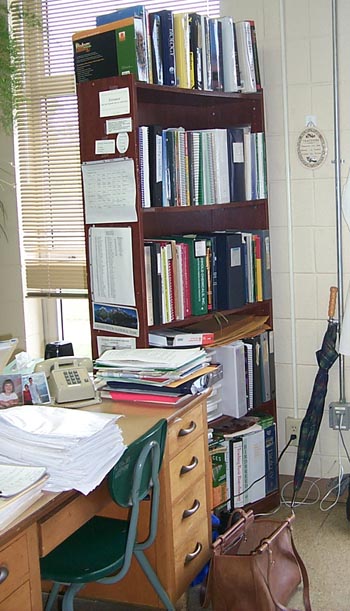 Becky’s bookcase holds resource books and materials, as well as her rubber stamp collection.
Becky’s bookcase holds resource books and materials, as well as her rubber stamp collection.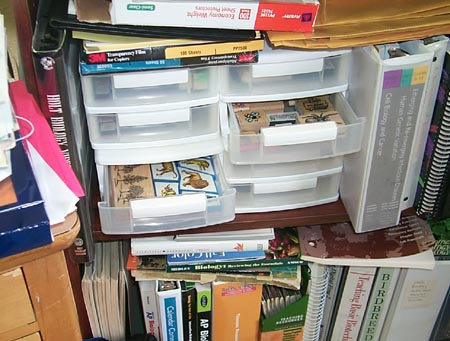 A close-up view of Becky’s bookcase shows plastic drawers containing her rubber stamp collection. Becky uses the stamps to designate checked student homework and multiple test versions.
A close-up view of Becky’s bookcase shows plastic drawers containing her rubber stamp collection. Becky uses the stamps to designate checked student homework and multiple test versions.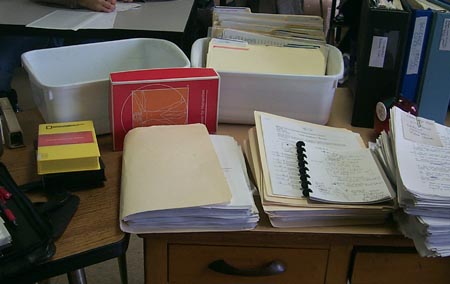 Students turn papers in to the empty dish tub. At the end of the day, Becky sorts the papers by class period, binds them together with a large black plastic binder clip and takes them home for grading. The second dish tub holds departmental folders filed alphabetically. The dish tub file holder is a cheaper alternative to the metal file holders that contain her unit materials.
Students turn papers in to the empty dish tub. At the end of the day, Becky sorts the papers by class period, binds them together with a large black plastic binder clip and takes them home for grading. The second dish tub holds departmental folders filed alphabetically. The dish tub file holder is a cheaper alternative to the metal file holders that contain her unit materials.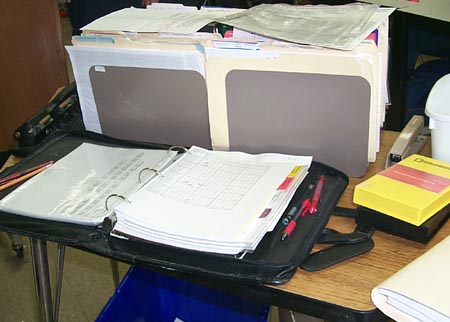 Becky’s personal space extends past her desk and onto a trapezoid table holding her plan book and two metal file holders with unit copies and materials. Becky calls these file holders one of her “best expenditures.” Materials for regular biology are in one and AP biology are in the other. The notebook contains masters for the current unit (handouts, labs, and activities) as well as this year’s and last year’s plans. Attendance sheets are on top of the notebook so that she can stand and check as students enter the classroom at the beginning of the period.
Becky’s personal space extends past her desk and onto a trapezoid table holding her plan book and two metal file holders with unit copies and materials. Becky calls these file holders one of her “best expenditures.” Materials for regular biology are in one and AP biology are in the other. The notebook contains masters for the current unit (handouts, labs, and activities) as well as this year’s and last year’s plans. Attendance sheets are on top of the notebook so that she can stand and check as students enter the classroom at the beginning of the period.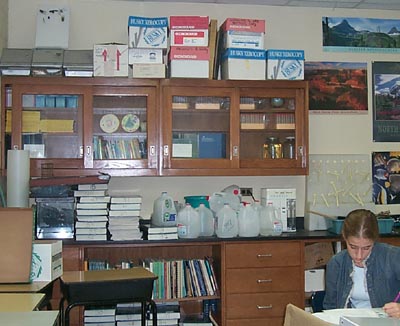 Lightweight boxes containing unit-specific materials are stored on top of the back wall cabinets. Class sets of books are also stacked in the back. Students are not required to bring their books to class. Becky finds that student copies of books have less wear and texts are accessible when needed.
Lightweight boxes containing unit-specific materials are stored on top of the back wall cabinets. Class sets of books are also stacked in the back. Students are not required to bring their books to class. Becky finds that student copies of books have less wear and texts are accessible when needed.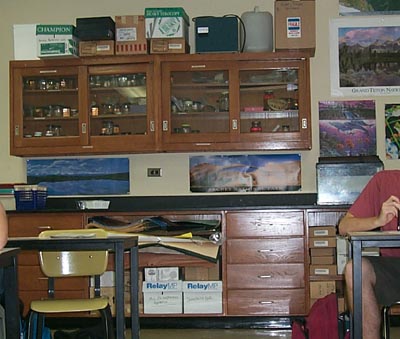 Becky keeps a large amount of counter space open so that she has room for organizing tubs for labs.
Becky keeps a large amount of counter space open so that she has room for organizing tubs for labs.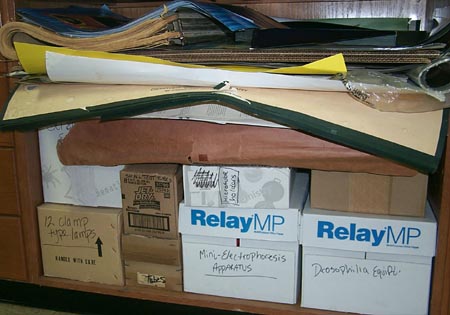 Unit posters are stored flat on an open shelf. At the beginning of her career, Becky stored posters rolled but finds that her current system allows for easier access and less wear on posters.
Unit posters are stored flat on an open shelf. At the beginning of her career, Becky stored posters rolled but finds that her current system allows for easier access and less wear on posters.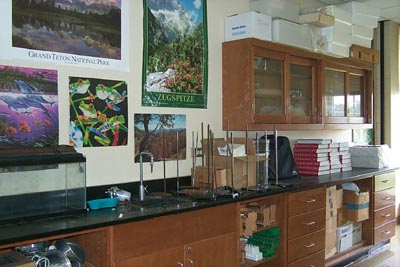 Another view of the back counter. An empty aquarium is used for various live animals during the year.
Another view of the back counter. An empty aquarium is used for various live animals during the year.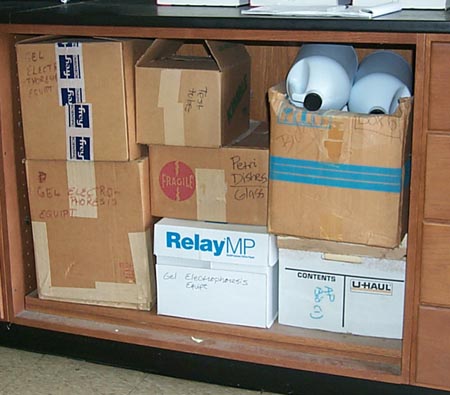 Removing shelves from cabinets allows for more storage space. Becky stores unit/lab materials in labeled cardboard boxes.
Removing shelves from cabinets allows for more storage space. Becky stores unit/lab materials in labeled cardboard boxes. Students work in groups of two or three at tables during labs. Each table has a raised floor outlet underneath to plug in equipment.
Students work in groups of two or three at tables during labs. Each table has a raised floor outlet underneath to plug in equipment.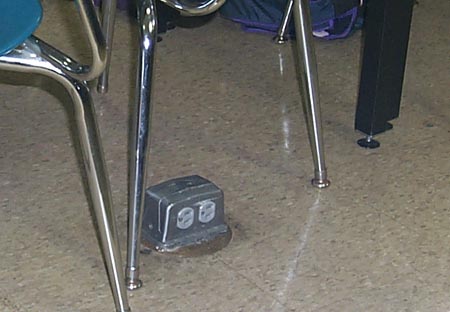 A potential tripping hazard, Becky’s raised floor outlets limit the possibilities for arranging student tables.
A potential tripping hazard, Becky’s raised floor outlets limit the possibilities for arranging student tables.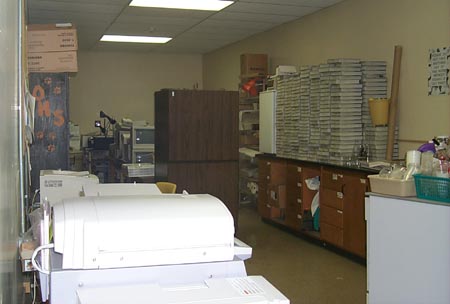 One of four science department storage rooms adjoins Becky’s classroom. Various materials and equipment are stored here. One of Becky’s favorite recent additions is a portable dishwasher that can be hooked up to one of her classroom sinks to ease cleanup after labs.
One of four science department storage rooms adjoins Becky’s classroom. Various materials and equipment are stored here. One of Becky’s favorite recent additions is a portable dishwasher that can be hooked up to one of her classroom sinks to ease cleanup after labs.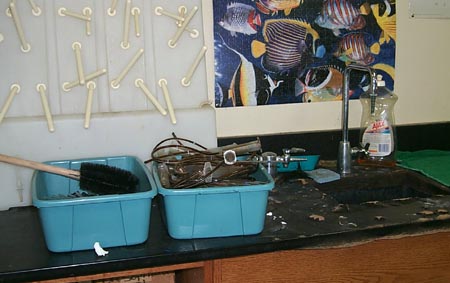 An area at the back of the room is used for washing materials after a lab. A beaker drying rack, dish tubs, and soap are placed at this cleanup area. The portable dishwasher is brought in for large loads that don’t require hand washing.
An area at the back of the room is used for washing materials after a lab. A beaker drying rack, dish tubs, and soap are placed at this cleanup area. The portable dishwasher is brought in for large loads that don’t require hand washing. An emergency shower is located next to the filing cabinets behind Becky’s desk. Her computer is on a cart that can be rolled quickly out of the way for easier access. Goggle storage and sterilization are in the white wall cabinet.
An emergency shower is located next to the filing cabinets behind Becky’s desk. Her computer is on a cart that can be rolled quickly out of the way for easier access. Goggle storage and sterilization are in the white wall cabinet.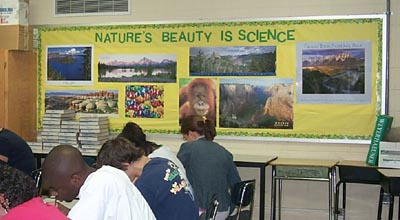 Becky uses posters of nature and from her travels to create a welcoming environment. When appropriate, she references posters as part of her lessons. Tables and desks under the bulletin board extend her back counter space.
Becky uses posters of nature and from her travels to create a welcoming environment. When appropriate, she references posters as part of her lessons. Tables and desks under the bulletin board extend her back counter space.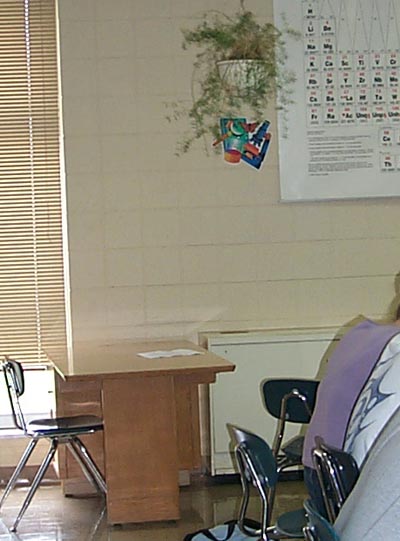 An empty desk at the back of the room provides a space for student teachers and for students completing makeup exams.
An empty desk at the back of the room provides a space for student teachers and for students completing makeup exams.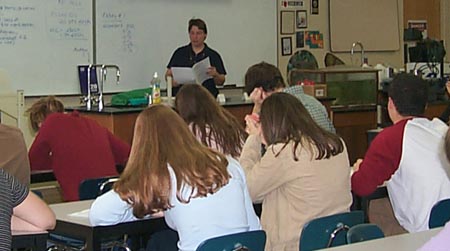 Becky answers questions regarding the day’s test. She creates and distributes two test versions so that students sitting next to each other don’t have the same test. Becky’s front stationary counter, one of three classroom sinks, and the fish tank can be seen.
Becky answers questions regarding the day’s test. She creates and distributes two test versions so that students sitting next to each other don’t have the same test. Becky’s front stationary counter, one of three classroom sinks, and the fish tank can be seen.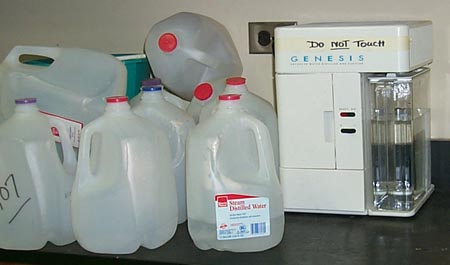 Although it still takes time (eight hours/gallon), purchasing a distiller for $200 to distill water for labs saves the science department money over the long term.
Although it still takes time (eight hours/gallon), purchasing a distiller for $200 to distill water for labs saves the science department money over the long term. Each year, Becky posts a list of students who pass the AP Biology placement test. The lists seem to encourage current AP Biology students who see names of graduates they know on the wall. She has even had former students come in to see their names posted.
Each year, Becky posts a list of students who pass the AP Biology placement test. The lists seem to encourage current AP Biology students who see names of graduates they know on the wall. She has even had former students come in to see their names posted.
 Front view of Becky’s personal space arrangement. She creates an extended desk area by lining up a bookcase, her desk, and a trapezoidal table. Lining the wall behind her chair are multiple filing cabinets containing unit plans and departmental information.
Front view of Becky’s personal space arrangement. She creates an extended desk area by lining up a bookcase, her desk, and a trapezoidal table. Lining the wall behind her chair are multiple filing cabinets containing unit plans and departmental information. Becky’s bookcase holds resource books and materials, as well as her rubber stamp collection.
Becky’s bookcase holds resource books and materials, as well as her rubber stamp collection. A close-up view of Becky’s bookcase shows plastic drawers containing her rubber stamp collection. Becky uses the stamps to designate checked student homework and multiple test versions.
A close-up view of Becky’s bookcase shows plastic drawers containing her rubber stamp collection. Becky uses the stamps to designate checked student homework and multiple test versions. Students turn papers in to the empty dish tub. At the end of the day, Becky sorts the papers by class period, binds them together with a large black plastic binder clip and takes them home for grading. The second dish tub holds departmental folders filed alphabetically. The dish tub file holder is a cheaper alternative to the metal file holders that contain her unit materials.
Students turn papers in to the empty dish tub. At the end of the day, Becky sorts the papers by class period, binds them together with a large black plastic binder clip and takes them home for grading. The second dish tub holds departmental folders filed alphabetically. The dish tub file holder is a cheaper alternative to the metal file holders that contain her unit materials. Becky’s personal space extends past her desk and onto a trapezoid table holding her plan book and two metal file holders with unit copies and materials. Becky calls these file holders one of her “best expenditures.” Materials for regular biology are in one and AP biology are in the other. The notebook contains masters for the current unit (handouts, labs, and activities) as well as this year’s and last year’s plans. Attendance sheets are on top of the notebook so that she can stand and check as students enter the classroom at the beginning of the period.
Becky’s personal space extends past her desk and onto a trapezoid table holding her plan book and two metal file holders with unit copies and materials. Becky calls these file holders one of her “best expenditures.” Materials for regular biology are in one and AP biology are in the other. The notebook contains masters for the current unit (handouts, labs, and activities) as well as this year’s and last year’s plans. Attendance sheets are on top of the notebook so that she can stand and check as students enter the classroom at the beginning of the period. Lightweight boxes containing unit-specific materials are stored on top of the back wall cabinets. Class sets of books are also stacked in the back. Students are not required to bring their books to class. Becky finds that student copies of books have less wear and texts are accessible when needed.
Lightweight boxes containing unit-specific materials are stored on top of the back wall cabinets. Class sets of books are also stacked in the back. Students are not required to bring their books to class. Becky finds that student copies of books have less wear and texts are accessible when needed. Becky keeps a large amount of counter space open so that she has room for organizing tubs for labs.
Becky keeps a large amount of counter space open so that she has room for organizing tubs for labs. Unit posters are stored flat on an open shelf. At the beginning of her career, Becky stored posters rolled but finds that her current system allows for easier access and less wear on posters.
Unit posters are stored flat on an open shelf. At the beginning of her career, Becky stored posters rolled but finds that her current system allows for easier access and less wear on posters. Another view of the back counter. An empty aquarium is used for various live animals during the year.
Another view of the back counter. An empty aquarium is used for various live animals during the year. Removing shelves from cabinets allows for more storage space. Becky stores unit/lab materials in labeled cardboard boxes.
Removing shelves from cabinets allows for more storage space. Becky stores unit/lab materials in labeled cardboard boxes. Students work in groups of two or three at tables during labs. Each table has a raised floor outlet underneath to plug in equipment.
Students work in groups of two or three at tables during labs. Each table has a raised floor outlet underneath to plug in equipment. A potential tripping hazard, Becky’s raised floor outlets limit the possibilities for arranging student tables.
A potential tripping hazard, Becky’s raised floor outlets limit the possibilities for arranging student tables. One of four science department storage rooms adjoins Becky’s classroom. Various materials and equipment are stored here. One of Becky’s favorite recent additions is a portable dishwasher that can be hooked up to one of her classroom sinks to ease cleanup after labs.
One of four science department storage rooms adjoins Becky’s classroom. Various materials and equipment are stored here. One of Becky’s favorite recent additions is a portable dishwasher that can be hooked up to one of her classroom sinks to ease cleanup after labs. An area at the back of the room is used for washing materials after a lab. A beaker drying rack, dish tubs, and soap are placed at this cleanup area. The portable dishwasher is brought in for large loads that don’t require hand washing.
An area at the back of the room is used for washing materials after a lab. A beaker drying rack, dish tubs, and soap are placed at this cleanup area. The portable dishwasher is brought in for large loads that don’t require hand washing. An emergency shower is located next to the filing cabinets behind Becky’s desk. Her computer is on a cart that can be rolled quickly out of the way for easier access. Goggle storage and sterilization are in the white wall cabinet.
An emergency shower is located next to the filing cabinets behind Becky’s desk. Her computer is on a cart that can be rolled quickly out of the way for easier access. Goggle storage and sterilization are in the white wall cabinet. Becky uses posters of nature and from her travels to create a welcoming environment. When appropriate, she references posters as part of her lessons. Tables and desks under the bulletin board extend her back counter space.
Becky uses posters of nature and from her travels to create a welcoming environment. When appropriate, she references posters as part of her lessons. Tables and desks under the bulletin board extend her back counter space. An empty desk at the back of the room provides a space for student teachers and for students completing makeup exams.
An empty desk at the back of the room provides a space for student teachers and for students completing makeup exams. Becky answers questions regarding the day’s test. She creates and distributes two test versions so that students sitting next to each other don’t have the same test. Becky’s front stationary counter, one of three classroom sinks, and the fish tank can be seen.
Becky answers questions regarding the day’s test. She creates and distributes two test versions so that students sitting next to each other don’t have the same test. Becky’s front stationary counter, one of three classroom sinks, and the fish tank can be seen. Although it still takes time (eight hours/gallon), purchasing a distiller for $200 to distill water for labs saves the science department money over the long term.
Although it still takes time (eight hours/gallon), purchasing a distiller for $200 to distill water for labs saves the science department money over the long term. Each year, Becky posts a list of students who pass the AP Biology placement test. The lists seem to encourage current AP Biology students who see names of graduates they know on the wall. She has even had former students come in to see their names posted.
Each year, Becky posts a list of students who pass the AP Biology placement test. The lists seem to encourage current AP Biology students who see names of graduates they know on the wall. She has even had former students come in to see their names posted.